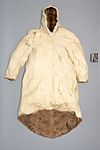ilupaaq (Inner Parka)
About this object
History of use
Long overcoats were worn by men during winter while hunting because the waist length coats did not provide enough warmth in these circumstances. They were usually worn with the hair to the outside, however, and had similar chest panels as the waist length coats worn underneath. Coats with the hair to the inside were worn underneath an outer coat with the hair to the outside. The tape of cloth was sewn along the hem to prevent it from rolling up.
The insulating capability of animal skins is enhanced by the practice of wearing two layers of skin clothing, especially in winter. The clothing also is designed so as to minimize ingress of wind and cold. During winter men and women normally wear two hooded waist-length coats, two pairs of trousers, two pairs of stockings and boots, and mittens. While mass-produced clothing from the south is now commonly worn, the making of skin clothing is being revived in the Arctic. In the Arctic, the making of clothing is considered as important as the creation of sacred objects. Aside from its important function as protection against the cold, clothing is imbued with power and spirituality. Women as seamstresses play an extremely important role in the expression of cultural value and meaning. The clothing of each group is cut and decorated according to distinctive cultural aesthetics. In addition to expressing the group’s identity, seamstresses express the beliefs and values of the group through clothing, which marks social identities like gender, age, childbearing status, and geographical origin. Clothing also expresses the special relationship of people in the Arctic with the animal world. People, animals, and spirits are subject to metamorphosis. Clothing often refers to this ability to transform, and could effect such a metamorphosis.
Narrative
Pierce donated this collection to the UBC Geology Museum in 1932, from which it transferred to the newly-opened Museum of Anthropology in 1948. Michell Pierce put together this collection of examples of Copper Inuit clothing and implements, while working in the area for the Hudson’s Bay Company. Before going to the area, he interviewed Dean Brock and M.Y. Williams about the possibility of collecting for UBC while there. This was the second collection he assembled, as the first was lost when the ship carrying the materials was caught in the ice.
Specific techniques
The pieces are sewn together with an overcast stitch.
Physical description
Men’s inner coat, or parka, of caribou skin with the fur on the inside. The coat has a close fitting pointed hood, rounded shoulders. It is knee length in the front and reaches well below the knees in the back. The hood is trimmed with a band of white fur.
Categories
Materials
